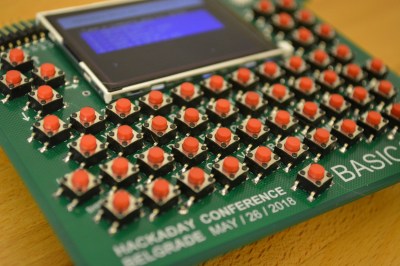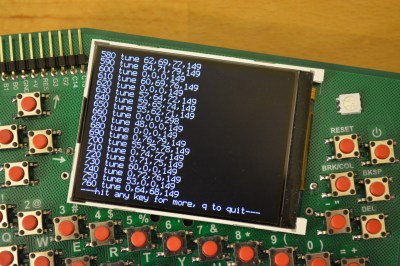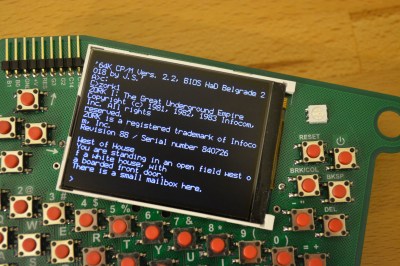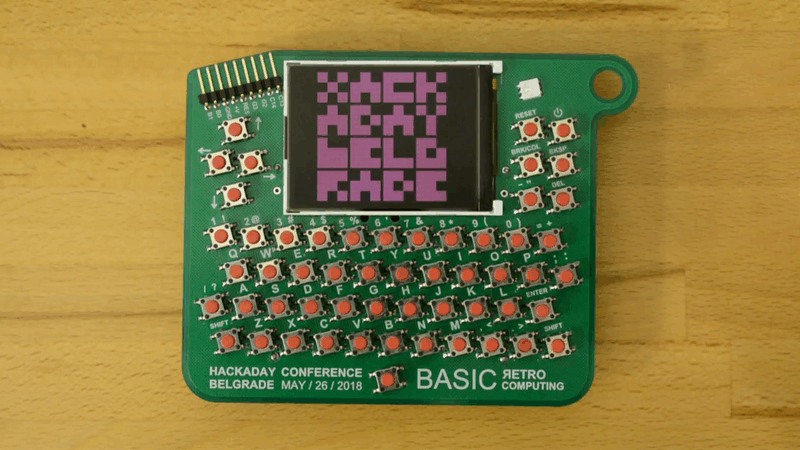The hardware badge for the Hackaday Belgrade conference is a Retro Computer that you wear around your neck. I have one in my hands and it’s truly a work of art. It’s beautiful, it’s fun to play with, and it will be an epic platform for a glorious weekend of badge hacking! Check out the first look video, then join me below as I drill down into the details.
Get your ticket now for Hackaday Belgrade, our premier European hardware conference at the end of this month. It’s a day filled with talks, works, food, fun, and of course everyone through the door gets one of these incredible badges. The best part is the community that turns out for this event and that includes the Hacker Village that takes hold in the evening. We’ll be hacking the badges until the wee hours of the morning alongside hardware demos, presentations, lightning talks, and live IDM and DJ sets.
Sweet Hardware
This badge feels incredible. The concept and hardware design are the work of Voja Antonic who is already in Belgrade making sure the manufacturing process goes smoothly. Since everyone who attends the conference will get a badge there’s a lot of hardware to produce!
Voja is a master at including artful choices in his designs. I love the shape of this badge, with the lanyard hole to one side. But the opposite corner having a slight bevel pulls the shape in a very interesting direction, along with the gently rounded bottom corners. The angled switches are mesmerizing in a way that a straight grid would not have been, and Voja’s choice of a cross-hatched ground pour in the top copper gives a pleasing texture that you might not have noticed, but would miss if it were taken away. This badge is gorgeous.
 When I think of a retro computer the things that come to mind are a clicky keyboard, and a green (or amber) monochrome display. This badge easily satisfies keyboard lovers with 55 momentary push buttons. The screen itself is full color so it can do monochrome, and at 320×240 it has the feel of a low-res CRT, operating in 40×20 character VT100 mode by default (more on this in the software section).
When I think of a retro computer the things that come to mind are a clicky keyboard, and a green (or amber) monochrome display. This badge easily satisfies keyboard lovers with 55 momentary push buttons. The screen itself is full color so it can do monochrome, and at 320×240 it has the feel of a low-res CRT, operating in 40×20 character VT100 mode by default (more on this in the software section).
The surprise that will bring a smile to your face is the PCB mounted speaker on the back. It can be driven with three voices and sounds just great! You’ll find one RGB LED module on the front, as well as an expansion header for programming, serial, I2C, and some GPIO. All of this is driven by the PIC32MX370F512H, along with a two megabyte flash chip for storing programs. If this was all available as a computer back in the day it would have dominated the industry: 48 MHz, 512 kB flash storage, and 128 kB of RAM.
The badge I have is one of 5 ‘mark 2’ prototypes — the originals didn’t have the speaker, were based on a PIC24 chip, and this version steps up from AAA to AA. The production badges have black solder mask and an acrylic bezel for the back, but everything else remains the same. Learn more on the page project page.
Delightful Software

To hold it in your hands is something special, but the software is what makes it come alive. Voja’s original idea was a badge that has a BASIC interpreter but we have so much more than that. Having found a very old post on the Microchip forums from him about BASIC for PIC, we reached out to Jaromir Sukuba — well known on Hackaday.io and winner of the Coin Cell Challenge earlier this year. Jaromir agreed to come on board and write the software for the project. Please take the time to thank Jaromir for this, it has turned into a huge project!
 For those that want purity in their Retro Computing experience, Jaromir has a couple of things for you. Notably, the badge is running CP/M on a Z80 emulator. CP/M is a very popular operating system for computers of the Z80 vintage, and to proof out the system we’ve been running Zork! But this is certainly not limited to games. The badge as a ROM drive for CP/M that includes xmodem. Using a USB to TTL serial cable you can transfer programs onto one of the three 512 kB drives which use that Flash chip for storage. Of course you can also transfer badge to badge.
For those that want purity in their Retro Computing experience, Jaromir has a couple of things for you. Notably, the badge is running CP/M on a Z80 emulator. CP/M is a very popular operating system for computers of the Z80 vintage, and to proof out the system we’ve been running Zork! But this is certainly not limited to games. The badge as a ROM drive for CP/M that includes xmodem. Using a USB to TTL serial cable you can transfer programs onto one of the three 512 kB drives which use that Flash chip for storage. Of course you can also transfer badge to badge.
Also a huge throwback is a copy of Tiny BASIC that is running in an unaltered form. This is not the main BASIC interpreter on the badge, but dating back to the 1970’s it’s fun to challenge yourself to do something really interesting with the barebones interpreter. For those that want a refresher, here’s the Tiny BASIC manual dating back to 1979.
The main event on the badge is the Hackaday BASIC interpreter that has been customized to make full use of all the badge functions. It has the ability to save and load programs from 16 storage slots, but it can also transfer programs onto and off of the badge over serial. It drives the music on the badge using a simple scripting language. There are words for controlling the LEDs, twiddling GPIO on the pin header, and taking more direct control of the display by changing colors, moving the cursor, controlling screen refresh, and using the extended ASCII character set. You can check out the software for yourself by visiting this repository.
All of this truly does make it a retro computer in your hands. I can’t wait to see hundreds of these being typed on and bringing joy to a conference full of hardware geeks!
Incredible Demoscene
The badge hacking ceremonies will be at midnight, giving everyone around 14 hours to do something special with the badge. We want to see all levels of hacking, from people who have never programmed making the LEDs blink, to veterans of the demoscene blowing the stock firmware away with their custom code.
Start dreaming up your hacks now. If you have them, bring along a USB-to-serial cable and/or PIC programmer (we’ll have some on hand, but the more the better). There are awards for the best music, best demo, best BASIC, best CP/M, and a few other categories of hacks. But it isn’t the awards that make this fun, it’s showing off your creativity for others who will truly appreciate it. These are your people, you need to be at Hackaday Belgrade.
Get your ticket and come make some memories with us!




















So, um, where do I put my name on it so that other people will know who I am?
Bring along to the event an adhesive backed paper badge that says “Hello, my name is (state your name)” and apply it to the LCD.
LOL
I’m going to have to do that now. Or maybe just make another badge with my name on it. It’d be easier. :)
That’s another question I have. Will there be actual badges, with names on them, or should we bring our own?
Program it into the badge!
Also, there’s white silk screen on the back to write you name on.
Neither the screen nor the silkscreen (strategically placed on the back) are large enough for it to be seen. Why is this called a badge? I understand it’s a cool homebrew computer gadget included in the ticket price, that’s fine, it’s awesome even. I can’t wait to play with it myself. But carrying it on your neck is kinda useless.
Why is this called a badge? It just evolved from the badge.
Same as when you “dial” or “hang up” the phone.
Except I just call a number and end the call.
Someone is going to add dailup internet to this. Or maybe a PS2 keyboard port. Or a baby SDR. Or neural networks. Or CAN bus talking
Congrats on some really awesome hardware design Voja!
bring your SHA2017 badge from last year. if you have put it away with your name on the screen, it will probably even bee there. No need to charge the lipo
I will bring several SHA badges for those in badge need :)
10 PRINT “Hello, I’m deshipu”
20 GOTO 10
Sorry for not seeing your answer before. I made a small improvement on it.
Simple:
10 input n$
20 print “My name is”, n$
30 goto 20
So I guess if you guys want to out-batch your batch at every conference, you’re going to end up giving away FPGA boards next time?
*Out-badge your badge. Wake up Jac.
I understood it as producing more than needed, but then I also interpreted it as going beyond what was needed…
Which I think is the point!
B^)
I don’t look forward to a year when “improvements” will be difficult (e.g. war, zombie apocalypse, parts shortages, …)
But the hacking and the stories of how people got there will be amazing. For the badge “I found 10 tubes of Soviet 4 bit micros in an abandoned factory”. Seminars will include “the effects of ultrasonics on the undead”, “small scale electricity production”, “sneaky ways to sneak past army patrols” and “Digital data transmissions over shortwave”
Good point!
“But the hacking and the stories of how people got there will be amazing.”
in other words…
“Scars are like tattoos, but with better stories.”
B^)
That was proposed by Miodrag and a few others. He turned the idea into a workshop and will lead FPGA 101 with a custom add-on board he designed for an FPGA Dev board.
Cool!
Can it play…
B^)
If it had included RF, the lanyard hole could have doubled as a loop antenna.
(just saying)
B^)
interesting but … WHY not FPGA!!!
48Mhz Fpga is equivalent 130-250Mhz in cp/m machine.
second trouble is USB. Sorry but today we need power and communication of usb
Because a $20 FPGA is equivalent to a $2 microcontroller
There’s also the eZ80 chip which has on-board flash and ram and can run CP/M plus has a lot of useful features such as ethernet support etc.
So, where do those of us who cannot travel to Serbia pick one up?
If we have extra we’ll likely sell them on Tindie. But tickets are getting close to sold out and we didn’t do a big overrun on this one so I can’t say for sure that will end up happening.
I assume that the gerbers, BOM, and code is going to be open-sourced…
Sure they will
+1 :D
‘Sure they will’ would be interpreted very differently, depending on tone, where I come from
At this moment, there are there are three files on the project page: PCB (CS), production Gerbers (panel with 3 PCBs) and BOM (xlsx).
Code is not finished yet, but you can pick the current version at https://github.com/Hack-a-Day/basic-badge
+1 Pleeeaassseeeeeeee!
Hared to get across to the con from Japan….
It looks like an ILI9341 display; you can get modules between 2.2-3.5″ for about $5-10 from ebay/amazon/aliexpress/taobao/etc, and the SPI communication protocol is well-documented in a handful of libraries including some from Adafruit.
Although, they do support a parallel interface as well if you get one of the panels with 30-40 pins on the ribbon cable – I haven’t seen as much public work on those.
Why does the headline animation read “XACKADAY BELGRADE”?
Well, you figured out Belgrade, which stumped me…
That’s not an “X”, that’s the Jolly Wrencher!
B^)
That’s the Greek letter Chi, like in TeX.
So it’s pronounced “Kackaday”? I’ve been saying it wrong for *years*! :P
Caca-a-day
It’s in Belgrad, so yeah, Chi fits pretty well.
Two reasons: (1) It is the “low res” Jolly Wrencher (2) “Hackaday” in Cyrillic is spelled with a https://en.wikipedia.org/wiki/Kha_(Cyrillic) So it’s a little in-joke.
I see. What if you made the extra two pixels that would make it an “H” flicker on/off randomly? Might be a cool effect…
Can’t believe I’ve never heard of XMODEM. Admittedly I’m not old enough to have used dial up (etc), but I do remember it (23). Looked it up–exactly what I needed for my Unix serial hacking project.
Zmodem was the best. I used it to download files from several Wildcat and Spitfire BBSes back in the day.
Some calculator’s used it as well.
nuttx would be a nice fit on this hardware
I’d *LOVE* one of these! Unfortunately, I’m not going to be able to be in Belgrade… Any idea how much they’d cost if there are extras?
Mind that selling extra ultracool badges would help fund the conference.
If you want a Retro Badge, why not make a miniature Sinclair ZX80, and program it in integer Basic. You would have to design it such that the display blanks whenever you make a keystroke.
It’s amazing how simple the schematic is for this.
Some one requested that they sell them. “They are porn.” To Geeks, Nerds, and hackers. Of course they are.
Can I buy one even if I’m not going to the conf?
Out of curiosity. Do they intend to make another run of these and sell them on Tindie.com for about $50.00 or so?
They are cool and a fun way to introduce programming to young STEM students. Not to mention a neat way to fund your conferences. I bought a Wyolum BADGr v4.0 from seeedstudio.com for $50.00 and I use it for many different things and it is still available.
any plans for an updated 2019 badge with esp32?